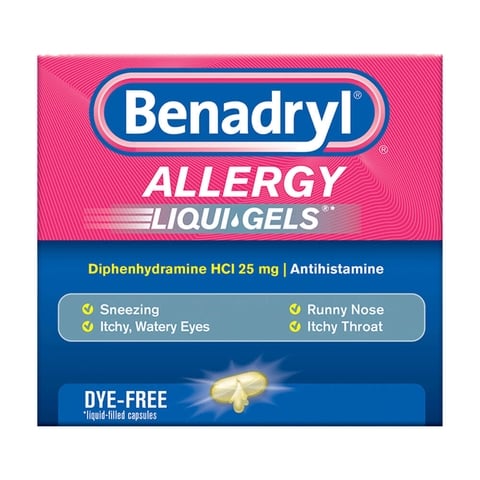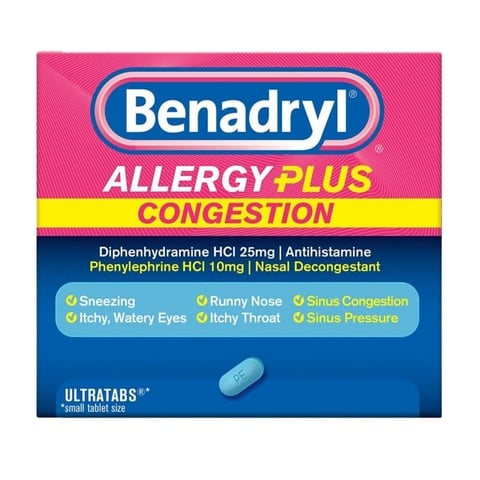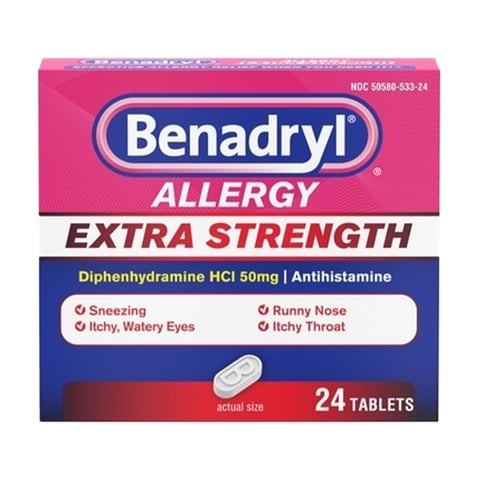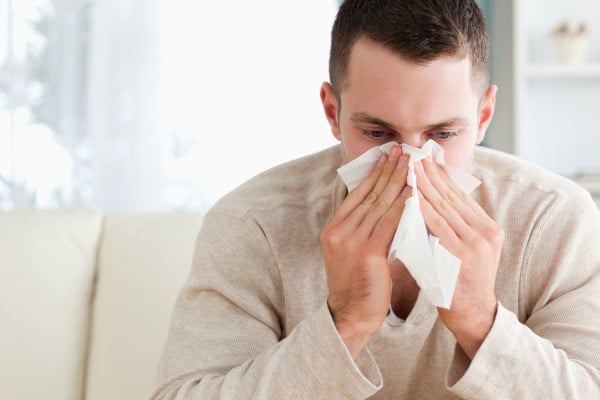A major key to coping with allergies is to be prepared. If allergens catch you off guard, you’ll be piling up tissues and suffering through symptoms. But, if you plan ahead and limit your exposure to allergens, you can make it harder for allergies to dampen your day.
By using our allergen action guide and prevention tips below, you can stay one step ahead of your allergy triggers and help better manage your symptoms.
Know and Avoid Your Triggers
The first step in treating and preventing allergies is to know your triggers and avoid them. You might notice your allergies getting worse during certain seasons, or in certain environments. One way to confirm your allergies is to undergo allergy testing. The most common test is a skin prick (scratch) test, where your healthcare provider uses thin needles to gently prick the skin with a panel of allergens to see if a reaction occurs.1
The most common allergy triggers include:2
- Pet dander, saliva, and urine
- Dust and dust mites
- Mold and mildew
- Food
- Pollen and ragweed
- Insects
How to Prevent Allergies by Allergen
Avoiding your allergy triggers is the best way to prevent reactions, but it isn’t always possible. Here are some tips for allergy sufferers by allergen on how to best limit exposure and prevent symptoms from keeping you down.
Cat, Dog, and Pet Allergies
If you’re a pet allergy sufferer, dealing with allergies can be difficult when you live with a furry friend. Pet allergies are caused by skin flakes from cats and dogs—known as dander—along with their saliva and urine. Contrary to popular belief, pet fur and hair aren’t causes of allergies.
If you don’t want to part with your pet, try these tips to help limit your pet-related allergies:3
- Keep pets out of your bedroom; most people spend up to half of their time sleeping, so try to limit your exposure during this time
- Limit pets to a specific area of the house that can be easily cleaned—preferably with no carpets or upholstered furniture
- Try to keep them off of couches, chairs, and other upholstered surfaces that can harbor dander
- Regularly wash bedding and other blankets in hot water and dry using a hot dryer to help avoid allergy symptoms at night
- Groom/wash pets at least once a week outside, if possible, to prevent releasing dander into the air and onto surfaces in your house
Dust Allergies
Dust can be found everywhere, but it is easier to control in your home. Dust allergies are not only caused by dust, but tiny creatures that live in dust known as dust mites. They thrive in humid environments, living in the inner layers of carpet, furniture, bedding, and even stuffed toys.4
To get rid of dust mites and dust in your home, try these cleaning and dusting tips for allergies:4
- Wipe down surfaces regularly with a damp cloth to clean away dust without putting it into the air
- Wash sheets, bedding, and stuffed toys weekly in hot water and dry in a hot dryer to kill off dust mites
- Cover pillows and mattresses in dust mite-proof covers—these block dust mites from getting inside
- Avoid using large carpets in your house—if you do have to have a carpet, try to make it low-pile
- Use roller blinds instead of curtains for shade to minimize the surface area for dust to settle on
- Choose leather, vinyl, or plastic furniture over upholstered furniture
- Use a dehumidifier to keep humidity below 50%
Mold Allergies
Mold and mildew love to grow in damp places, like bathrooms, basements, and kitchens. They can also grow outdoors during the fall and winter months, especially in piles of leaves and rotting logs. Spores from mold and mildew are responsible for causing allergy symptoms, so cleaning up any spots you see in your house will help.5
To help prevent mold and mildew from settling down in your house, try these tips:5
- Use a dehumidifier in humid rooms in your house, like the basement or laundry room
- Clean up garbage, piles of clothing, bedding, and old books and newspapers, which can hold onto moisture
- Quickly repair any leaks or plumbing issues to prevent water from escaping and seeping into floors and walls
- Avoid drying clothes indoors
- Keep rooms well-ventilated—after showering or bathing, run a fan or open doors/windows to let moisture escape
Food Allergies
For those living with food allergies, the only way to prevent a reaction is to avoid the allergen. Reactions to food allergens can range from mild to severe symptoms—such as anaphylaxis. With this, it’s important to take extra precautions to avoid allergens and stay vigilant.6
Some tips for food allergy prevention include:6
- Read ingredient labels and check packaging thoroughly to make sure that your allergen is not included
- When eating in restaurants, let your waiter/waitress know about your allergies to avoid accidental exposure
- Make a plan before traveling, and pack your own food if possible
- Avoid foods that have been manufactured in facilities that also process your allergens—there may have been cross-contamination
Pollen, Ragweed, & Seasonal Allergies
Typically, during spring and summer months, trees, grasses and weeds begin growing and blooming. This spreads tiny grains of pollen throughout the air, setting off allergies in many people across the country.
Pollen allergy tips include:8
- Keep windows and doors closed during days with high pollen counts
- Wash bedding regularly in hot water to remove pollen you might bring in from outside
- Limit time outdoors during high pollen season
- Cover your hair and eyes when going outside to prevent pollen from sticking
- Dry clothes in your dryer, not by hanging them outside
Insect Bites or Stings
Insects like mosquitos, bees, and wasps can bite or sting, setting off allergic reactions in some people. Most of the time these are mild, local reactions such as a small itchy bump where the bite/sting was. However, in more severe cases, they can result in a life-threatening anaphylaxis reaction. If you are severely allergic, be sure to carry an epinephrine pen with you when outside.9
Other tips to avoid bites and stings from pesky insects include:9
- Leave hives and nests alone, and hire a professional exterminator to clear them away
- Try not to wear brightly colored clothing or perfume when outside—many insects will mistake you for a flower
- Be cautious when cooking and eating outdoors, especially sweet drinks and treats—these can attract insects
- If a bee or wasp does fly up to you, remain calm and slowly move away
- Wear bug spray or natural repellants to keep mosquitos at bay—especially when near swampy areas or if you’re out at nighttime
If you do happen to have a mild reaction after being bitten, BENADRYL® makes several topical treatments to help alleviate itchiness.
Other Allergy Prevention Tips
Along with the above ideas, here we’ll offer some more general tips and tricks on how to keep allergens out of your home.
Clean and Vacuum Regularly
Cleaning and vacuuming regularly can help prevent accumulation of dust and dander. It’s important to note that these tasks will generally stir allergens up into the air, so you may notice your allergies become temporarily worse.
Chores, Then Outdoors
When performing chores like dusting, sweeping, and vacuuming, try to wear a dust mask to prevent allergies from flaring. Afterward, head outside for a bit to avoid the allergens you may have stirred up.
Use an Air Purifier
Keep the air inside your home filtered and clean with an air purifier! Replace the filter inside with a high-efficiency particulate air (HEPA) filter to help eliminate allergens floating around in the air.
Keep Windows Closed
We all love fresh air, but on windy days or when pollen count is high, allergens can find their way into your home. Be sure to seal doors and windows tight to keep out pollen and dust.
Check on Pollen Count in the Area
During allergy seasons, you can check pollen count just like you would a weather forecast. This count will tell you what the amount of pollen is in the air right now, along with what plants are responsible for it. This can help you limit your time outdoors on days where you may be most affected.
Change Clothes or Take a Shower
After coming back home from a day outdoors, try to change your clothes soon after arriving, and put them in a laundry basket in a separate room. Showering or bathing can also remove allergens from your skin and hair.
Remedies for Treating and Managing Allergy Symptoms
While allergies may seem inevitable, there are plenty of treatment options to help prevent and relieve your allergy symptoms, including:
- Antihistamines, like BENADRYL® Allergy ULTRATABS®
- Antihistamines with decongestants, like BENADRYL® Allergy Plus Congestion
- Decongestants, like BENADRYL® Allergy Plus Congestion
- Topical allergy medicines, like Extra Strength BENADRYL® Itch Stopping Cream
- Allergy eye drops
- Nasal sprays
- Immunotherapy or allergy shots
- Rescue medications, like epinephrine (EpiPen) to be used in case of anaphylaxis
Related Articles
References
- Cleveland Clinic. Allergy Testing. July 2, 2021. Accessed from: https://my.clevelandclinic.org/health/diagnostics/21495-allergy-testing
- Asthma and Allergy Foundation of America. Types of Allergies. October 2015. Accessed from: https://www.aafa.org/types-of-allergies/
- Asthma and Allergy Foundation of America. Pet Allergy: Are You Allergic to Dogs or Cats? October 2015. Accessed from: https://www.aafa.org/pet-dog-cat-allergies/
- Asthma and Allergy Foundation of America. Dust Mite Allergy. October 2015. Accessed from: https://www.aafa.org/dust-mite-allergy/
- Asthma and Allergy Foundation of America. Mold Allergy. October 2015. Accessed from: https://www.aafa.org/mold-allergy/
- American College of Allergy, Asthma, & Immunology. Food Allergy Avoidance. Accessed from: https://acaai.org/allergies/management-treatment/living-with-allergies/food-allergy-avoidance/
- Asthma and Allergy Foundation of America. Pollen Allergy. February 2022. Accessed from: https://www.aafa.org/pollen-allergy/
- Mayo Clinic. Allergies. August 4, 2020. Accessed from: https://www.mayoclinic.org/diseases-conditions/allergies/diagnosis-treatment/drc-20351503
- American Academy of Allergy Asthma & Immunology. Stinging Insect Allergy. Accessed from: https://www.aaaai.org/Conditions-Treatments/Allergies/Stinging-Insect-Allergy





